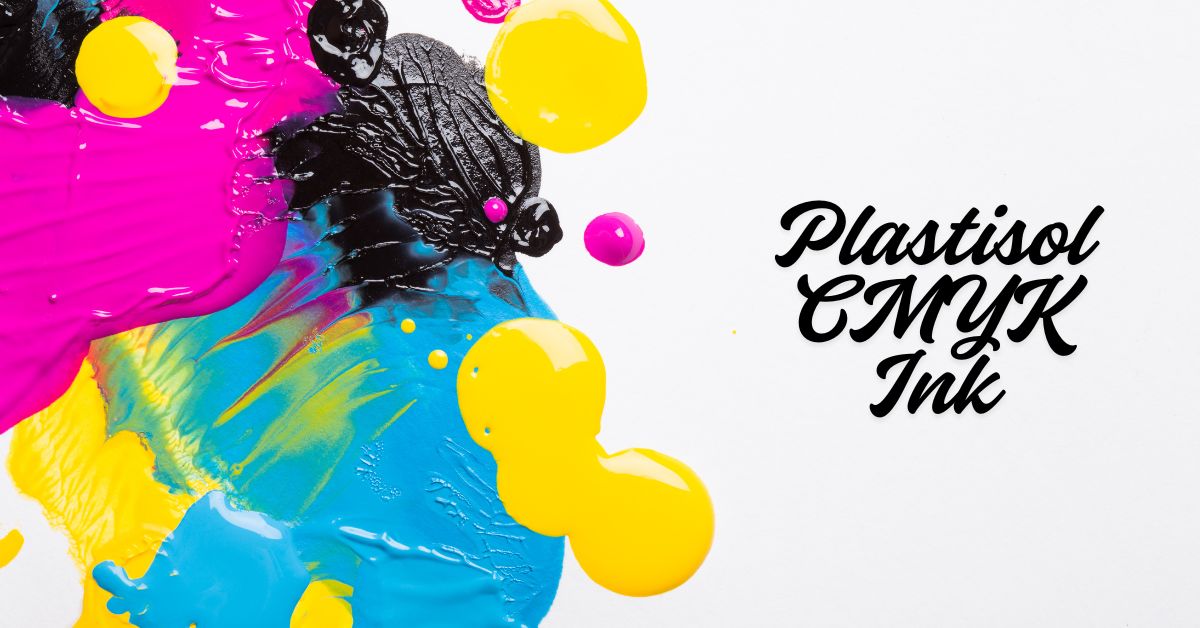For those entering the world of garment printing, the terminology can feel like a different language. Among the most common—and misunderstood—terms is plastisol CMYK ink. If you’ve ever wondered how full-color images appear so crisply on t-shirts, hoodies, or fabric posters, chances are plastisol CMYK ink played a major role.
Plastisol CMYK ink is a screen printing method that combines plastisol, a PVC-based ink medium, with the CMYK color model (Cyan, Magenta, Yellow, and Black) to reproduce full-color images on fabric. This technique allows printers to render photographs, gradients, and complex multicolor designs with impressive detail and longevity.
But there’s more beneath the surface. From ink chemistry and mesh counts to curing temperatures and halftone dots, plastisol CMYK printing is both an art and a science. This in-depth guide explores everything a beginner or pro needs to know—without the sales pitch, just the facts.
Understanding the Basics: What Is Plastisol Ink?
Plastisol ink is a type of ink primarily used in textile screen printing. Unlike water-based inks, plastisol does not dry through evaporation. Instead, it cures—a process that involves heating the ink to around 320°F (160°C) to cause it to solidify and bond permanently to the fabric.
Key Features of Plastisol Ink:
- Durability: Plastisol prints are known to last through hundreds of washes.
- Vivid Colors: High opacity and sharpness make it ideal for bold, eye-catching prints.
- Fabric Versatility: Works well on both light and dark garments, depending on the base layer used.
Plastisol is thick, plasticky, and long-lasting—making it the industry standard for commercial textile printing.
READ MORE: Exploder 5 Firecracker: Understanding Its Power, Purpose, and Modern Use
What Is CMYK Ink in Printing?
CMYK stands for Cyan, Magenta, Yellow, and Key (Black)—a color model used to reproduce full-color images through a process of subtractive mixing. In print, CMYK is used instead of RGB (Red, Green, Blue) because CMYK corresponds more directly to pigment-based color reproduction.
How CMYK Works in Print:
- Images are broken down into four separate layers, one for each ink.
- Each layer is screened through a halftone pattern, which turns gradients into tiny dots.
- When printed together and viewed from a distance, these dots blend to form the illusion of full color.
This process is common in magazines, packaging, and, yes—textile screen printing using plastisol inks.
So, What Exactly Is Plastisol CMYK Ink?
Plastisol CMYK ink is the use of plastisol-based ink for four-color process printing on garments. It combines the physical robustness of plastisol with the visual precision of CMYK separations.
This technique allows printers to:
- Reproduce photographic images
- Maintain sharpness even on stretchy or irregular textiles
- Create soft prints on light garments without heavy layering
CMYK plastisol printing differs from spot color printing, where each color is printed using a specific ink mix. Instead, all colors are derived from combinations of the four CMYK inks.
The Process: How Plastisol CMYK Printing Is Done
Screen printing with plastisol CMYK inks is more complex than single-color prints. Here’s a step-by-step breakdown:
1. Image Preparation
- Convert the original image to CMYK color mode.
- Use software like Adobe Photoshop or RIP software to generate halftone separations.
- Ensure each color separation includes proper dot angle and frequency (typically 45° for black, 75° for magenta, 105° for yellow, and 15° for cyan).
2. Screen Making
- Each color gets its own screen, coated with photo emulsion and burned with the halftone pattern.
- Screens must be perfectly aligned to prevent blurring or color shift.
3. Ink Mixing and Printing
- Use transparent plastisol CMYK inks, not opaque spot colors.
- Print each layer in order, usually starting with yellow, then magenta, cyan, and black.
- Careful control of squeegee pressure and mesh tension is crucial.
4. Curing
- Once all layers are printed, the shirt is passed through a conveyor dryer to cure the plastisol ink at 320°F.
- Proper curing is essential for wash durability and color fidelity.
The Technical Aspects That Matter
To achieve top-tier results with plastisol CMYK printing, several technical variables must be controlled:
Mesh Count
- Typical CMYK plastisol printing uses 305 to 355 mesh count screens.
- Higher mesh counts allow finer dots, crucial for detailed images.
Dot Gain
- As ink spreads slightly on fabric, dot gain must be compensated during prepress.
- RIP software and experience help manage this.
Off-Contact Distance
- Distance between screen and fabric should be precise—often 1/16″—to prevent smudging.
Flash Curing
- Some printers use a flash cure between layers to prevent smearing, though this is debated in CMYK workflows.
Underbase
- Usually avoided in CMYK printing on white shirts.
- For dark garments, a “simulated process” approach using opaque underbase and highlight whites may be preferred instead of pure CMYK.
Common Applications for Plastisol CMYK Ink
Despite its complexity, CMYK plastisol ink is the go-to method when photo-realistic printing on textiles is required.
Common Use Cases:
- Band merchandise featuring album covers or portraits
- Full-color custom t-shirts for marketing or events
- High-detail prints for fashion and boutique brands
- Limited edition art prints on fabric
Because of its visual impact and consistency, CMYK plastisol printing remains highly valued in premium apparel production.
Advantages and Disadvantages
Pros:
- Durability: Outlasts water-based and discharge inks
- Vibrant colors: Rich and consistent across large runs
- Photorealistic detail: When executed properly, can match photo-quality standards
- Flexibility: Works on cotton, poly blends, and even performance fabrics
Cons:
- Not breathable: Thick ink layers may feel heavy
- Environment: PVC-based; not biodegradable
- Learning curve: Requires experience in separations and printing
- Limited on dark garments: Unless underbase or simulated process used
Is Plastisol CMYK Printing Sustainable?
Environmental concerns around plastisol primarily stem from its PVC base and the use of phthalates, although modern formulations have moved toward phthalate-free alternatives.
Sustainability Considerations:
- Use phthalate-free plastisol inks.
- Implement eco-friendly mesh reclaim and cleaning solvents.
- Optimize curing temperatures to reduce energy consumption.
- Offer recycling programs for end-of-life textiles.
While not the most eco-friendly option, plastisol can be part of a sustainable workflow if managed responsibly.
Plastisol CMYK vs. Other Methods
| Feature | Plastisol CMYK | Water-Based | DTG (Direct to Garment) |
|---|---|---|---|
| Durability | Very High | Moderate | Low to Moderate |
| Color Vibrancy | High | Medium | High |
| Cost per Unit | Medium | Medium | High (Low volume) |
| Setup Time | High | High | Low |
| Best For | Large runs, vivid images | Soft feel | Small batches |
Each method has its place, but plastisol CMYK continues to dominate high-volume, high-resolution garment printing, especially in commercial settings.
Tips for Beginners
- Start with simple images with high contrast before moving to full-blown photographic prints.
- Invest in RIP software to handle halftone conversions accurately.
- Work on white shirts to avoid complications with underbase.
- Practice ink management—stir well, maintain temperature, and store properly.
- Join a print community or forum for troubleshooting help.
Industry Trends and Innovations
As digital integration spreads through screen printing, new tools are improving CMYK plastisol workflows:
- AI-assisted color separations for better color balance
- Low-cure plastisol inks to save energy and prevent fabric scorch
- Hybrid printing: combining DTG with plastisol for best of both worlds
- Cloud-based prepress solutions for remote collaboration on large print jobs
These trends point to an exciting future where traditional screen printing and digital innovation converge.
READ MORE: TamilCrow: The Rise, Reality, and Ripple Effect of a Piracy Giant
Final Thoughts
Plastisol CMYK ink represents a perfect harmony of color science, material chemistry, and craftsmanship. For those willing to master its intricacies, the payoff is massive: visually stunning, wash-resistant, high-resolution images that pop off the fabric.
Whether you’re starting a clothing brand, expanding your print shop, or simply exploring new techniques, plastisol CMYK ink deserves a place in your workflow. It may be traditional, but it’s far from obsolete.
Would you like this guide turned into a downloadable PDF, infographic, or printable checklist for print shop use?
FAQs
1. Can I use regular plastisol inks for CMYK printing?
No. CMYK printing requires transparent process inks, not opaque spot colors. Regular plastisols won’t blend correctly to produce full-color effects.
2. Is plastisol CMYK ink suitable for dark garments?
Not ideally. Pure CMYK works best on white or light-colored garments. For dark shirts, use a simulated process or add a white underbase.
3. How many screens do I need for CMYK printing?
You’ll need four screens—one each for cyan, magenta, yellow, and black. Each must be perfectly registered.
4. What mesh count should I use?
For CMYK plastisol printing, use a high mesh count—typically 305 or above—to hold fine halftone dots.
5. Is plastisol CMYK printing eco-friendly?
Not by default. But using phthalate-free inks, optimizing curing temperatures, and reducing waste can make it more sustainable.









